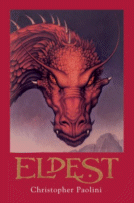Eldest by Chistopher Paolini Review
Knopf, August, 2005Hardcover, 704 pages
ISBN: 037582670X
Young Adult

Christopher Paolini has grown as an author and that is quite evident in Eldest, the sequel to the bestselling Eragon. At the end of the last book, the teenage Eragon and his blue-skinned dragon Saphira had helped win a great battle, but the war is far from over. King Galbatorix, the Alagaesian Empire's cruel ruler has learned of Eragon and Saphira's existence and he wants control of the Dragon Rider. He is also determined to crush the resistance to his totalitarian rule. In order to further his training, Eragon and Saphira travel to Ellesmera, the forest home of the elves. In Ellesmera, Eragon undergoes an interesting transformation as he learns the skills of a Dragon Rider from the wise and powerful elf Dragon Rider Oromis and his elderly dragon Glaedr. Both Saphira and Eragon learn some hard lessons in the forests of Ellesmera, and even have their first major disagreement which must be worked through in order for them to be a powerful team in the battles to come.
Meanwhile, Eragon's cousin is still in their hometown of Carvahall. King Galbatorix has sent a terrifying emissary to find Eragon and the dragon egg, and that could mean the destruction of the town. Roran has to grow up quickly as he convinces the entire town to relocate in order to survive. Their trek turns Roran into a hardened warrior: and he has a big surprise waiting for him when he finally sees that his long-lost cousin Eragon is now a mighty warrior.
At nearly 700 pages, Eldest could have used a bit of editorial pruning. Although Paolini uses a blend of Tolkien and Anne McCaffrey's fantasy conventions (elves, dwarves, humans, dragon riders with telepathy etc.) there are many instances where Paolini steps outside the conventions and shows a vein of original thinking and creativity. Just when the dialogue is about to get too stilted, or the characters begin to become unbearably honorable and stuffy, someone usually steps forward to puncture their pompousness. For example, Angela the herbalist (who Paolini says he based on his own sister) is around on the battlefield to dispense terse advise and sly commentary. She's a delight. And new ruler Nasuada confounds the ruling council and a parsimonious neighboring king with her creative thinking: when she can't get the money she needs to fund the rebellion, she has the magicians create beautiful lace which is sold to the luxury market (it's hard to recall one fantasy novel where the market research and entrepreneurship was used to finance the raising of an army.) Paolini also excels at creating horrific creatures, such as the Ra'zac and the girl Elva, who was unwittingly cursed by Eragon and Saphira when she was a baby. The pacing of the last third of the book really picks up steam, as the plot charges to a thrilling conclusion. It will be a long wait until Book III: Inheritance.
--Claire E. White
Ordering information: Amazon.com
Return to the October 2005 issue of The IWJ.
